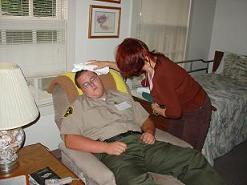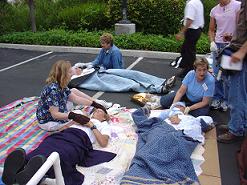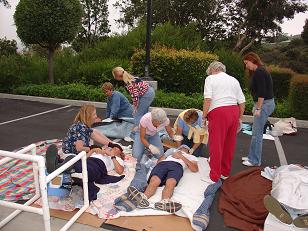Promoting Neighborhood Responsibility
Orange County, CA Disaster Preparedness Academy Prepares NW Participants
In recent years, we've all become intimately familiar with the images of post-disaster areas and the victims left in their midst. Whether a terrorist attack or a natural disaster, the devastation often seems unfathomable. While many who have been fortunate enough to avoid enduring such a major disaster firsthand maintain that “it will never happen in my community,” the reality is, disasters do happen. The question is: How will we respond? The Crime Prevention Unit of the Orange County (CA) Sheriff's Department has not only pondered that very question, it's developed a solid approach for enabling communities in its jurisdiction to not only prepare for, but also how to best respond to a catastrophe, should one occur.
 Awareness Meets Action
Awareness Meets Action
“Considering how densely populated our area is, we realized that if a large scale disaster were to occur, it would be possible that individual community members would be on their own for up to a week,” explained Jan Sener, the Director of Crime Prevention and Volunteer Programs at the Orange County Sheriff's Department. “We, along with the Orange County Fire Department and one of our local hospitals, Mission Viejo Hospital , recognized the need to instruct citizens on how to take care of themselves and their neighbors in the event of such a disaster.”
In the dawn of this realization, the three entities began working in collaboration with one another to begin brainstorming ideas for an approach that would be most effective. In the summer of 2004, the South Orange County Community Disaster Preparedness Academy was piloted in Mission Viejo . Following its success, the Academy extended throughout the region to the cities of Laguna Niguel, San Clemente, Rancho Margarita, Lake Forest, Laguna Hills, Aliso Viejo, and the unincorporated areas within the South Operations jurisdiction, all of which falls under Sener's responsibility.
With the help of the Red Cross, an eight-week curriculum was developed that provides training on every aspect of disaster preparation and response. For instance, CPR certification and first aid training is coordinated by the local Red Cross; fire safety training, including how to properly use a fire extinguisher and how to respond in the event of a fire, is presented by the Orange County Fire Department; and training related to identifying and reporting terrorist activity is offered by the sheriff's office.
Each session, which is offered in the evenings, consists of a class of 25 students or less.
 Authentic Experience
Authentic Experience
Beyond traditional classroom instruction, participants are placed in disaster simulations so that they can experience such a situation firsthand. “Participants face triage situations in which they have to take on such tasks as evaluating the conditions of disaster victims,” explained Sener. “Each Academy student learns how to appropriately identify and tag victims according to their medical status – from those needing immediate assistance, to those who will not easily be revived.” Sener said, while crucial, this portion of the training can be quite difficult, as it involves a high level of emotion.
Because actual disaster experiences trigger even more dramatic emotional responses, the Academy also features a section on psychology. “The instructor who teaches this portion of the course is actually a chaplain who spent a lot of time with victims of Hurricane Katrina, so he is able to offer a great perspective on how one may feel should they have to endure a catastrophic event,” said Sener.
Before graduating, each student participates in a mock large-scale disaster scenario. The class is divided into four groups, each of which must confront a different disaster situation. “There could be a collapsed building situation in which participants must not only contend with victims with varying degrees of trauma, but also downed power lines and other potentially dangerous situations,” explained Sener, who said these simulations typically take place at local fire houses. “The whole key to their success is working together as a team to evaluate the situation and effectively prepare the area for the responders. It's amazing how they just learn to work with one another, and it's interesting to watch an individual in each group just naturally assume a leadership role, which is absolutely crucial.”
 The Neighborhood Watch Connection
The Neighborhood Watch Connection
Sener knew it would be absolutely essential that the Academy be tied into the Neighborhood Watch Program. “We have such an active Neighborhood Watch program in Orange County with over 55,000 active participants in South Operations, so it just made sense that the Academy be designed for members,” said Sener.
So active is the program, in fact, that every community in the area has a Neighborhood Watch group and a corresponding block captain. “Invitations for the Academy are sent directly to block captains, and then it is up to them if they, themselves, will participate or open the invitation to members of their watch group,” said Sener. “In doing it this way, not only do we have the ability to reach out to numerous homes in a short amount of time, but we're also connecting with people who have already demonstrated an interest in their communities.”
In fact, Neighborhood Watch participants in Orange County must demonstrate quite a serious interest in their communities; the program is designed in a manner in which individuals must earn the right to be a part of it. “We have found that people generally have more interest in participating if they have had to make an effort to be involved.” That said, two meetings are required prior to Neighborhood Watch initiation. The first of these simply provides crime prevention officers on Sener's staff to provide information about the program, the department's commitment to the program, its functions and responsibilities, and the successes. The second involves providing participants with assistance in properly securing their homes and helping them understand what their role is in protecting their property and their community. “Essentially, we provide participants with the techniques, the information, and the resources they need to assume a high level of responsibility for their own safety and the safety of their neighbors.”
In addition to participating in initial meetings, each Neighborhood Watch group must meet at least once a year, hold by-monthly block captain meetings, and demonstrate a commitment to their neighborhood and to each other. Block captains are also required to remain actively involved. “If we are alerted to a block captain who is not participating in his or her Neighborhood Watch group, we notify that individual and let him or her know that a meeting is past due,” explained Sener, who also informs block captains that their Neighborhood Watch signs will be removed from their community if their group is not active. “That is like cutting off their air supply, and, fortunately, we've never had to do it. But we believe it is a necessary measure because it is extremely important that we maintain the integrity of the program.”
In just three years, the program has not only built a stellar reputation, it has helped residents better understand their role and learn how to best serve their communities in the event of a disaster. It has also provided participants with the critical tool of learning to work with others in such situations. As a result of the program's success, Sener says one of the primary goals for the future is to develop and organize a disaster drill that would invite graduates of the Academy back to participate in a more significant disaster simulation, likely held on a high school football field or gymnasium. “The Academy equips graduates with the tools they need to assess and determine what can and should be done in a disaster situation; offering participants the opportunity to experience a larger-scale catastrophic event will more deeply demonstrate the importance of people working together as a community,” said Sener. After all, community collaboration is what the Academy is really all about.



